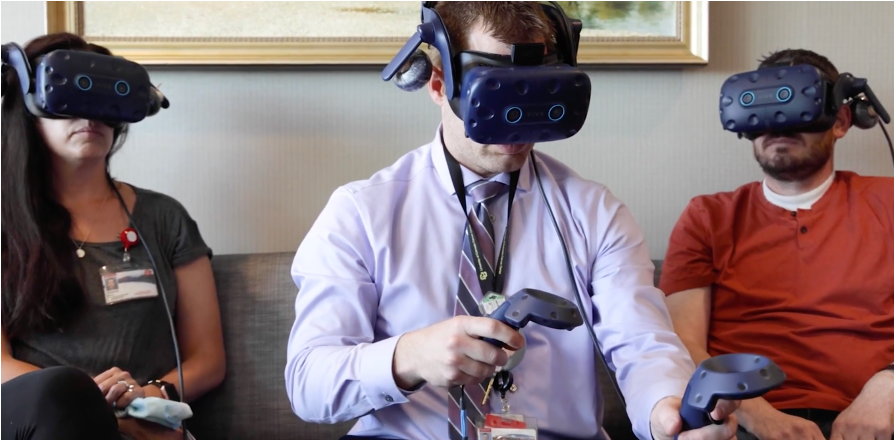Image courtesy of Douglas Holt, M.D.
Physicians use various strategies to explain tests or new procedures to patients. Beyond verbal discussions, they can employ handouts and videos, or suggest websites or other online resources. But some doctors say that hasn’t been sufficient in helping patients fully understand their results. That’s why more physicians are turning to virtual reality, a topic health journalists may want to cover because of its potential to augment patient education and engage people in care.
Virtual reality (VR) is a computer-generated simulation of a three-dimensional image or environment. People can interact with these images using electronic equipment such as a headset or gloves outfitted with sensors.
Sarah Hoffe, M.D., section head of gastrointestinal radiation oncology at Moffitt Cancer Center in Tampa, Florida, is evaluating the potential of VR to help train her patients for a specialized type of radiation treatment called MRI-guided radiation therapy. With this technique, patients lie in an enclosed space housing both MRI imaging as well as radiation delivery technology for up to 90 minutes. They are asked to hold their breath in 25-second intervals for 30 minutes.
Hoffe told AHCJ she could tell how scared her patients were when she would talk to them about the therapy during pre-treatment clinic visits. So, she decided to make a video explaining the procedure. She wrote a script and hired actors to portray a patient going through treatment, but it still wasn’t enough to calm patients. Even after watching the video, some patients showed up for appointments saying they couldn’t sleep the night before.
Hoffe began exploring VR. She formed a team with Edmondo Robinson, M.D., M.B.A., F.A.C.P, Moffitt’s chief digital officer. They collaborated with faculty at Moffitt and Ringling College of Art and Design and design student Joseph Jansen to develop two virtual reality games — one with a space theme and one with a golf theme — that teach patients how to hold their breath. VR also can be used to see what it would be like to lie inside the machine. Two patients treated at Moffitt offered insights. The team presented their design in August at the Healthcare Information and Management Systems Society (HIMSS) 2021 Global Health Conference & Exhibition, in Las Vegas. Now, she’ll be incorporating it into pre-treatment clinic visits to measure if it reduces patients’ anxiety and better prepares them.
Virtual reality to explain tumors
Douglas Holt, M.D., a radiation oncologist at Idaho Cancer Center in Idaho Falls uses VR to show patients 3D images of their tumors, explaining a tumor’s size and positioning and why it may be causing side effects. He also can demonstrate exactly what areas radiation treatments will target.
Holt started these efforts in his prior position as a chief resident at the University of Colorado Cancer Center. In early surveys of 25 patients at the center who had received the educational sessions, patients’ average rating of their understanding of their cancer jumped from 5.6 on a 10-point scale before VR to 9.2 afterwards. Over 80% said it was the best educational tool they had used; 97% agreed that VR should be standard of care. He presented the work this fall at the Association of Community Cancer Centers (ACCC) annual meeting.
“Virtual reality is a way to be a leveler for patients to help them actually understand and speak on the same level as their providers,” Holt said in a video produced by the ACCC, which presented him with one of its Innovator Awards for 2021. “More importantly, it can allow them to be engaged in their own care [and] to make decisions that they’re fully informed of.”
Other medical VR applications
Many other centers are employing VR in different areas of medicine. Some VR projects in health care have been featured during field trips at AHCJ’s annual Health Journalism conferences. At Health Journalism 2016 in Cleveland, neurosurgeons at the University Hospitals Case Medical Center presented a 3D VR surgical simulator that allows surgeons to view and interact with dynamic brain images of their patients before operating on them. At Health Journalism 2018 in Phoenix, field trip goers visited the Mayo Clinic’s Precision Neurotherapeutics Lab, where neurosurgeons and researchers use augmented reality to deliver more precise therapies.
A couple of years ago, I wrote an article for General Surgery News about a hospital in Spain that offered colorectal cancer patients VR-based tours to help decrease anxiety before surgery. During a preoperative visit, patients donned googles to see the entrance to the surgery floor, go down the hall to the operating rooms and recovery area, etc. They also could put an app on their phone or tablet to review as many times as they liked at home.
The 2021 meeting of the International Virtual Reality Healthcare Association featured presentations from researchers at different centers about the potential of VR to help in areas such as cognitive rehabilitation of stroke survivors, speech disorders and pain relief.
The U.S. Food and Drug Administration also seems to be interested in virtual and augmented reality in medicine. It held a public workshop in March 2020 to discuss evaluation techniques for medical “extended reality” devices. The agency also has been moving forward in approving some VR therapies and tools for patients and health care professionals:
- In October, it granted premarket approval for Luminopia One, a VR headset therapy for amblyopia (lazy eye) in children. It is designed to allow children to watch television shows and movies, while a software application modifies the content in real-time to rebalance visual input to the brain, aiming to strengthen the weaker eye.
- In November, it authorized marketing of EaseVRx, a prescription virtual reality treatment for chronic low back pain. The system includes a VR headset and breathing amplifier attachment to guide patients through deep breathing exercises. It uses cognitive behavior therapy methods such as attention-shifting and deep relaxation to address pain symptoms.
- Also in November, it authorized marketing of a surgical planning tool called InVisionOS. The technology is designed to convert a patient’s computed tomography (CT) scan into a 3D reconstruction that surgeons can view on a headset to practice manipulating and isolating certain anatomical areas prior to operating.
Tips for reporters
When writing about VR applications in health care, make sure to ask if there’s any data showing its efficacy, Hoffe said. VR, like other areas of medicine, should be evidence-based, she noted.
“Just because we made it or think it’s better, that doesn’t mean anything when we practice evidence-based medicine,” Hoffe said. “If you’re an executive at a health system and you’re deciding whether to invest in VR, I need to show you data so that you can make that determination.”
Holt agreed: “For AR/VR, the biggest challenge in medicine is capturing and demonstrating the actual value. [It’s a] question of how do you turn an expensive toy to a valuable tool and have proof/data to support this?”
Questions Holt recommends journalists to ask
- What is the value and how did/will they demonstrate the value of a particular use of VR?
- What preliminary or clinical trials are they working on?
- What problem are they trying to address or solve, and is VR the best tool for that?
- How can this be scaled/what is the future market for this product?
- What are the barriers to adoption or scaling?
Additional resources
- 3D Virtual Reality: Changing the Standard of Care for Patients with Cancer and Their Caregivers – Information about Douglas Holt’s work using VR to explain patients’ tumors to them, from the Association of Community Cancer Centers
- International Virtual Reality Healthcare Association – The 2021 meeting of this group covered presentations about the potential of VR to help in areas such as cognitive rehabilitation of stroke survivors, speech disorders, and pain relief.
- VR/AR Association – an international organization that fosters collaboration in virtual reality and augmented reality projects
- FDA Public Workshop on Medical Extended Reality: Toward Best Evaluation Practices for Virtual and Augmented Reality in Medicine – has links to videos and a transcript of the meeting
- Stanford Virtual Heart – a virtual reality tool to explain congenital heart defects
- Blog post about 10 uses of virtual reality in medicine, by Light IT








